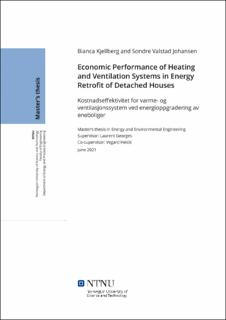| dc.contributor.advisor | Georges, Laurent | |
| dc.contributor.advisor | Heide, Vegard | |
| dc.contributor.author | Kjellberg, Bianca | |
| dc.contributor.author | Johansen, Sondre Valstad | |
| dc.date.accessioned | 2021-10-03T16:22:36Z | |
| dc.date.available | 2021-10-03T16:22:36Z | |
| dc.date.issued | 2021 | |
| dc.identifier | no.ntnu:inspera:80324182:69658837 | |
| dc.identifier.uri | https://hdl.handle.net/11250/2787179 | |
| dc.description.abstract | I forbindelse med Parisavtalen i 2015, satte Norge seg som mål å redusere drivhusgassene med 50% innen 2030. I 2019 gikk 23% av Norges energiforbruk til private husholdninger ifølge Statistisk Sentralbyrå. Videre er mer enn halvparten av dem eneboliger bygget av tre. Dette betyr at det eksisterer et betydelig energisparingspotensial hvis alle disse boligene ble energioppgradert.
Målet med denne masteroppgaven har vært å evaluere kostnads-, energi- og miljøytelsen til forskjellige VVS-løsninger som potensielt kan implementeres i norske trehus. Dette blir undersøkt på grunn av det store energibesparelsespotensialet, av den hensikt å informere sluttbrukere og til slutt å bidra til å nå det nasjonale klimamålet. Hvordan "prebound" og "rebound"-effektene påvirker kostnadseffektiviteten vil også bli undersøkt.
Denne masteroppgaven er relatert til NTNU/SINTEFs OPPTRE-prosjekt. OPPTRE-prosjektet har som mål å foreslå et nesten nullenerginivå ved renovasjon av eneboliger bygget av tre. Det er seks hus i OPPTRE-prosjektet, representative for typisk norsk arkitektonisk stil. To av disse husene skal i denne masteroppgaven analyseres og bygningskroppen skal renoveres til tre nivåer av energieffektivitet.
Ulike metoder brukes til å evaluere de tre ytelsesaspektene i denne studien. Standarden NS-EN 15459 (2017) ble hovedsakelig brukt til kostnadseffektivitetsanalysen. Når det gjelder energiytelsen, ble det gjort simuleringer i energisimuleringsprogramvaren IDA ICE. Nøkkelresultatet fra simuleringen er bygningens årlige energibruk. For å vurdere miljøpåvirkningen brukes CO2-faktorer for å konvertere energiforbruket til tilsvarende CO2-utslipp fra de forskjellige VVS-løsningene. "Prebound"- og "rebound"-effektene utforskes gjennom kompensasjon i energiforbruket. Dette innebærer lavere energiforbruk i det eksisterende huset og høyere energiforbruk i de renoverte scenariene.
Masteroppgaven belyser at renovering av eneboliger kan bidra til å redusere energibruken i den norske bygningsmassen ved å investere i kostnads- og energieffektive tiltak med lav miljøpåvirkning. Man kan konkludere med at flere av de utvalgte VVS-kombinasjonene er optimale, avhengig av energieffektiviteten til bygningskroppen og type enebolig. Resultatene indikerte i tillegg at optimal kombinasjon avhenger av hvordan man veier investeringens kostnadseffektivitet, energieffektivitet og miljøpåvirkning opp mot hverandre. | |
| dc.description.abstract | In the Paris Agreement of 2015, Norway agreed on aiming at a 50% reduction of greenhouse gas emissions by 2030. According to Statistisk Sentralbyrå, private households were responsible for around 23% of Norway's energy consumption in 2019. More than half of these private households were wooden dwellings. This means that there is a significant potential for energy savings if these wooden dwellings were to undergo an energy retrofit.
The objective of this master's thesis has been to evaluate the cost-, energy- and environmental performance of different HVAC-combinations that could potentially be implemented in Norwegian wooden detached dwellings. This is investigated because of the potential for considerable energy savings and for the purpose of enlightening end users. Ultimately, the thesis hopefully contributes to reaching the national climate target. The impact of the prebound and rebound effects on the cost effectiveness will also be explored.
This master's thesis is related to the NTNU/SINTEF’s project named OPPTRE. The OPPTRE-project aims at proposing a nearly Zero Energy Building (nZEB) level for deep energy retrofit of wooden detached dwellings. There are six houses in the OPPTRE-project, representative of the typical Norwegian architectural style. Two of these houses are in this master's thesis going to be analyzed and deep energy retrofitted to three levels of energy efficiency of the building envelope.
Different methods are used to evaluate the three performance aspects of this study. The standard NS-EN 15459 (2017) was mainly used for the cost performance assessment. Concerning the energy performance, simulations in the energy simulation software IDA ICE were done. The key output from the simulations is the annual energy consumption of the building. To assess the environmental impact, CO2-factors are used to convert the energy consumption into the equivalent CO2-emissions from the different HVAC-combinations. The prebound and rebound effects are explored through compensation in energy consumption. This implies calculating with lower energy consumption in the existing house and higher energy consumption in the retrofitted scenarios.
This thesis shows that deep energy retrofitting detached wooden dwellings can contribute to reducing the energy use of the Norwegian building stock through cost-effective and energy-efficient measures with low environmental impact. In conclusion, several of the considered HVAC-combinations could be optimal, depending on the energy efficiency of the building envelope and type of detached wooden dwelling. The results indicated additionally that which combinations are optimal, depended on the weighing of the investment's cost effectiveness, energy efficiency and environmental impact. | |
| dc.language | eng | |
| dc.publisher | NTNU | |
| dc.title | Economic Performance of Heating and Ventilation Systems of Detached Houses | |
| dc.type | Master thesis | |
